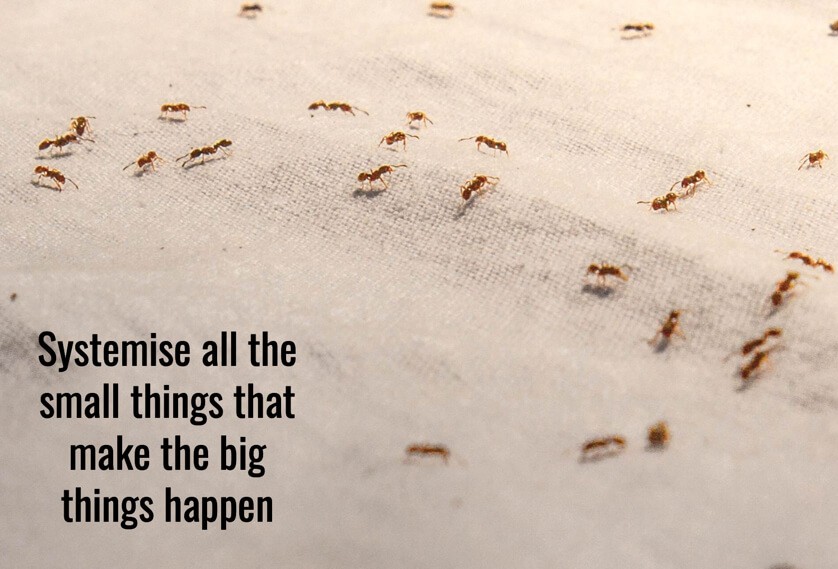My daughter opened her wardrobe door to show me the problem.
"See, no clean school shirts," she said, a look of horror on her face. Because this conversation was happening 12 minutes before we had to get in the car to go to school. And she had nothing clean to wear.
🙄
This isn't a story about a 10-year-old's emotional trauma. It's a story about systems. And how you must must must systemise all the small things in your MSP that make the big things happen.
I'm a massive fan of systems. I remember being utterly delighted when I first saw the word broken down into:
- Saves
- You
- Stress
- Time
- Energy, and
- Money
Because it's true! Systems don't restrict you; they free you. They make your business boring and predictable (this is a very good thing).
I've even systemised how my home runs. I'm a sole parent, and that potentially means a lot of work just to keep on top of everything a busy 10-year-old needs and wants.
It's a lot less work when you create a system and stick to it. For example, the washing system is:
- Everyone puts all dirty clothes in the laundry bin at the end of every day
- On Wednesdays Paul washes and dries all the clothes, and puts them in the ironing bag
- On Thursdays Paul puts the ironing bag outside the house for the ironing lady to pick up
- On Fridays the ironing lady delivers all the clothes ironed, and Paul puts them away in our wardrobes
Simple, right? It means I don't have to think about the washing, at all. I have much better things to think about, and better things to do with my life. So long as the system is followed, we always have clean ironed clothes readily available.
(By the way, the reason we suffered a washing system failure is explained at the end of this article)
Let's bring this back to your MSP. There's a 5 step process to systemising the small things that make the big things happen
Step 1:
Track your time
You know your day speeds by far too quickly. You're just never too sure why. Where does it go???
Don't guess what you're doing... know what you're doing by using a time tracker. Can't make good decisions without good data, right?
There are many time trackers available. I love, use and recommend Timeular, because it has a physical element to it: An 8-sided "dice" that you flip when you move from one task to another.
However you track your time, you're looking to identify three categories of work. I colour code them:
- Red tasks: I want to spend as little time on these as possible. Your red tasks would be 1st line tickets
- Yellow tasks: It's OK to do these, but in moderation. Your yellow tasks would be talking to your techs and doing 2nd/3rd line work
- Green tasks: You can spend as much time on these as you like. They're tasks that grow the business
Side note: Since last summer, when I started tracking every second of my working day, I've not only dropped down to working 30 hours a week again, but my net profitability is up. And I spend a large proportion of my time on green tasks. This is where I make the greatest contribution to my own business. And it's what gives me the most satisfaction at the end of each week.
Step 2:
Identify which of your tasks can be absorbed into a system
Any task that is repeated in any way can and should be systemised. It's as simple as that.
Step 3:
Figure out if you personally really need to do it... or whether you can DOA it
DOA stands for Delegate Outsource Automate - it's what you do with tasks that you personally don't really have to do.
The guiding principle for this is that you should only do, what only you can do. Everything else, you find someone else to do it for you, as quickly as resources allow. This is what 100% of the world's most successful people do.
Step 4:
Create simple briefs and standard operating procedures that anyone can understand
I've done a couple of in-depth articles on this in the past:
- How to find and properly brief a virtual assistant
- Flowcharts, checklists and video briefs: The secrets of DOA
Step 5:
Put checks in place
This is a critical step. Because when you have a good system that works well, you quickly learn to forget about the task!
But you need to have something in place that tells you quickly when the system has broken in some way. And preferably before it stops producing results.
Which brings me back to the washing story. Our system broke because my daughter decided to shove some of her dirty clothes in a drawer in her room, rather than the laundry basket.
Why? Because she's 10 🙄
She did this on and off for a few weeks. But she didn't do it consistently enough for me to notice the amount of washing going down and the number of school shirts reducing every week.
You'll be relieved to know our system is now back on track, with a weekly Friday night visual wardrobe check in place.




